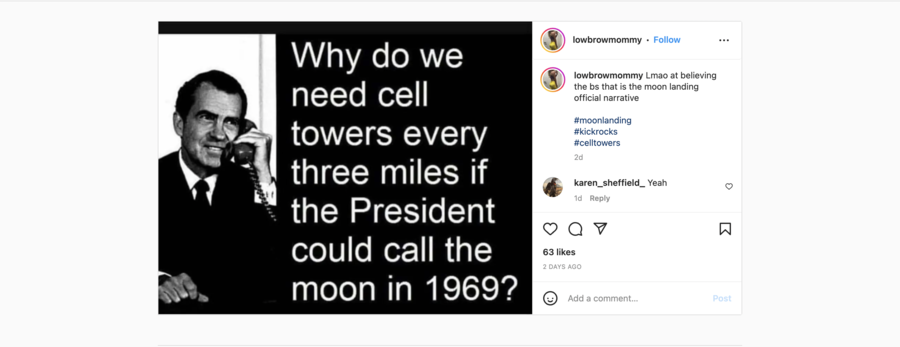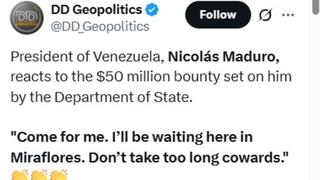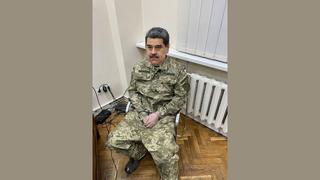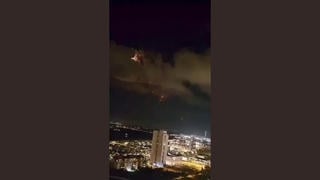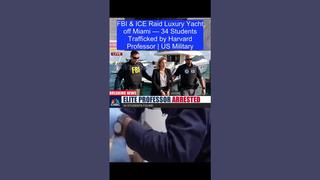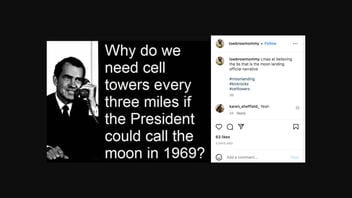
Does former President Richard Nixon's call without a string of cellphone towers prove that NASA never put astronauts on the moon? No, that's not true: A NASA spokesman explained to Lead Stories that the agency used massive radio antennas and ground tracking stations to connect Nixon with the astronauts. The nonexistence of cellphones in 1969, therefore, does not prove that such a call did not occur.
The implied claim was in the caption for an image posted on Instagram (archived here) on November 25, 2022. The left side of the image showed a black-and-white photo of Nixon talking on a phone. On the right side, the image's caption read:
Why do we need cell towers every three miles if the President could call the moon in 1969?
This is what the post looked like at the time of the writing:
(Source: Instagram screenshot taken on Mon Nov 28 15:17:19 2022 UTC)
The poster's accompanying comment read, "Lmao at believing the bs that is the moon landing official narrative #moonlanding #kickrocks #celltowers."
In June 2022, Lead Stories debunked a similar claim. In that fact check, we wrote that Nixon's July 20, 1969, call to astronauts Neil Armstrong and Edwin "Buzz" Aldrin went from Washington, D.C., to the Mission Control Center in Houston, to a Capsule Communicator (CapCom) and into outer space. NASA defines a Capsule Communicator as "the astronaut on Earth who communicates with the crew members in their spacecraft."
Ian J. O'Neill, a media relations specialist at NASA, elaborated further in a November 29, 2022, email to Lead Stories. After the CapCom in Houston received the call, the communication was passed on to the Mercury Space Flight Network (MSFN) and the Deep Space Network (DSN), he said. (Mercury was the original name, but it's called Manned now.
The DSN, set up in 1963, is a network of three "giant radio antennas," each with an area of about 1 acre, that constantly receive details about the location and status of spacecraft. Currently, one DSN is located in Goldstone, California, one is near Madrid, Spain, and the last is in Canberra, Australia. The California antenna was used for Nixon's call.
The MSFN was a set of tracking stations built near the DSN antenna sites to support the Mercury, Gemini, Apollo and Skylab space programs, if need be. (The 1969 flight to the moon was the Apollo 11 mission.)
In a December 1, 2022, email, chief engineer for the Deep Space Network Jeff Berner explained:
Basically, [the DSN] is the same as using a cell phone today - the antennas are way bigger, the transmitter way more powerful, the receiver way better, but in essence, the system would have been the same (only using 1960's technology as opposed to the miniaturized electronics used in phones and transmitters today). Of course, given the distance to the moon, there would be a delay in any response, due to the time it takes the signal to get to the moon and back.
A description of the phone call by the AT&T subsidiary, BellComms, which worked with NASA on the moon-call project, describes "how do you call the moon." (Jilane Rodgers Petrie, the director of public affairs for the Cellular Telecommunications and Internet Association [CTIA], flagged that explanation for Lead Stories in a November 29, 2022, email.)
Cellphones work differently from the DSN or the MSFN, as a comparison of a CTIA explainer of cellphone calls and NASA's explanations of the DSN or the MSFN makes plain.
Rather than relying on radio antennas, cellphones send out signals that are passed on to cell towers or a cell site located on a roof, streetlights or lamp posts. From there, the signals travel to a network switch or router and, via another cell site, on to their ultimate destination.
Additional Lead Stories fact checks of claims related to the 1969 mission to the moon can be found here.

